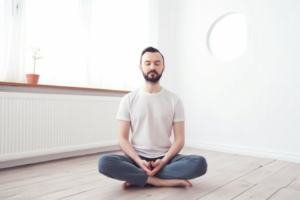Does an upcoming presentation make your heart race? Or do you feel an edge of constant dread, preventing you from enjoying life to its fullest? You’re not alone in this struggle. Anxiety can feel like an unwelcome visitor, overstaying its welcome. But, there’s a beacon of hope. Imagine if you could find a sense of calm amidst this whirlwind of worry? That’s the power of guided imagery, a technique that can help you take control and begin your journey towards a less anxious life. Intrigued? Let’s explore more.
Understanding Guided Imagery
Guided imagery is a potent technique that can help manage stress and anxiety. It involves using your imagination to create peaceful, calm images in your mind. It’s like a mental escape, helping you visualize a safe, relaxing place away from the worries and stresses of daily life. By conjuring up such tranquil scenarios, your body often responds as though you are physically there, promoting a sense of relaxation and calm.
How Does Guided Imagery Work?
The potency of guided imagery lies in the deep connection between our mind and body. When you’re gripped by anxiety, your body responds to your thoughts and fears as if they are real threats, setting off a stress response. However, when you visualize peaceful and calming scenarios, your body can respond by relaxing and promoting calmness.
Furthermore, guided imagery engages all the senses. You don’t just picture a relaxing scene; you imagine how it sounds, smells, feels, and even tastes. This multisensory experience makes the visualization feel more real, intensifying the relaxation and calmness.
See more:
- 5 Essential Exercises That Actively Fight Anxiety
- Discover Mindfulness for Generalized Anxiety Disorder: 5 Powerful Techniques to Alleviate Panic Attacks
- 7 Simple Steps to Stop Constant Worrying and Find Inner Peace
Guided Imagery Techniques for Anxiety
It might seem odd when you first begin with guided imagery, but with practice, it can become a powerful weapon in your arsenal against anxiety. Here are some basic steps to help you get started:
- Find a Quiet Space: Identify a quiet, comfortable spot where you won’t be disturbed.
- Close Your Eyes and Relax: Shut your eyes and take a few deep breaths to center yourself.
- Visualize a Peaceful Place: Imagine a peaceful, safe, and relaxing scene. This could be anything from a beach at sunset, a serene forest, or a warm, cozy room.
- Engage Your Senses: Deepen your experience by imagining what you can see, hear, smell, feel, and taste in your peaceful place. The more vivid the sensory experience, the more immersive and calming the visualization becomes.
- Ride the Wave of Relaxation: Remain in your peaceful place as long as you wish, letting the relaxation wash over you.
Conclusion
Managing anxiety can often feel like an uphill battle, but remember, you’re not alone, and there are practical, powerful tools that can help. Guided imagery is one such technique that can offer a retreat from the storm of anxiety. Why not give it a try? You might find it to be a transformative addition to your anxiety management strategy.


